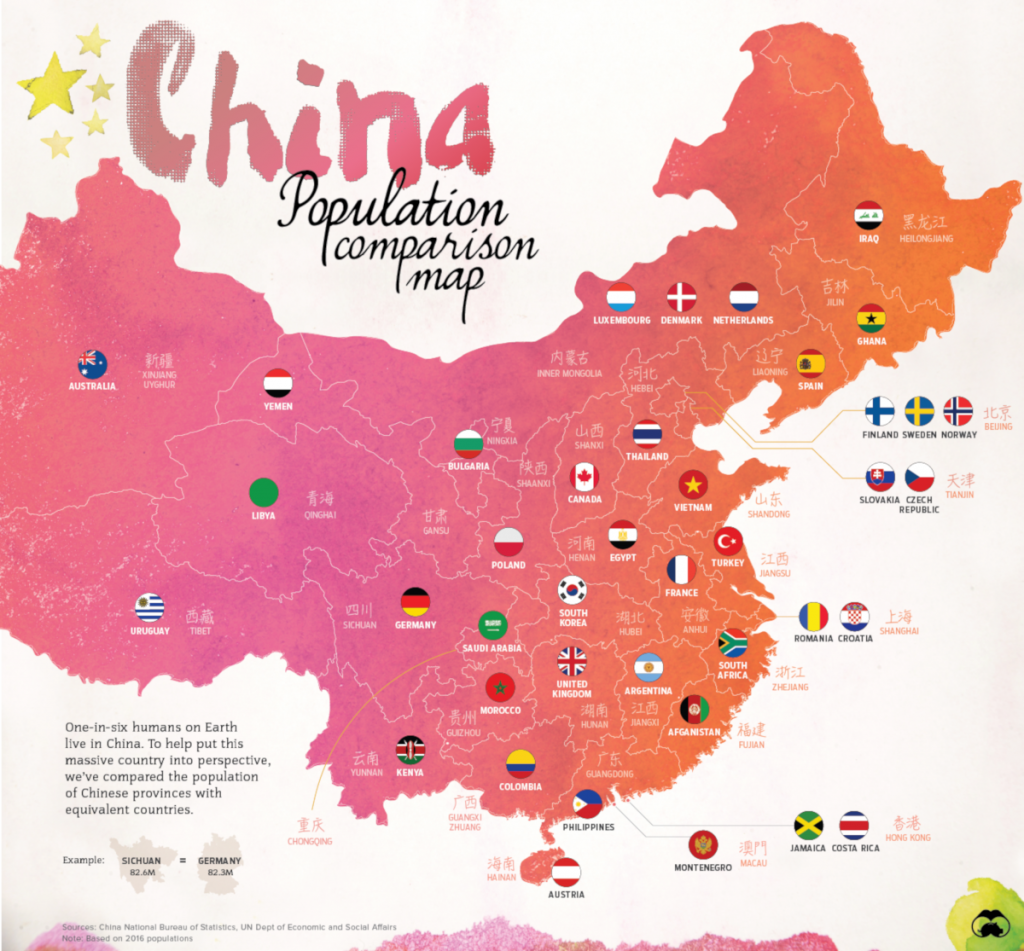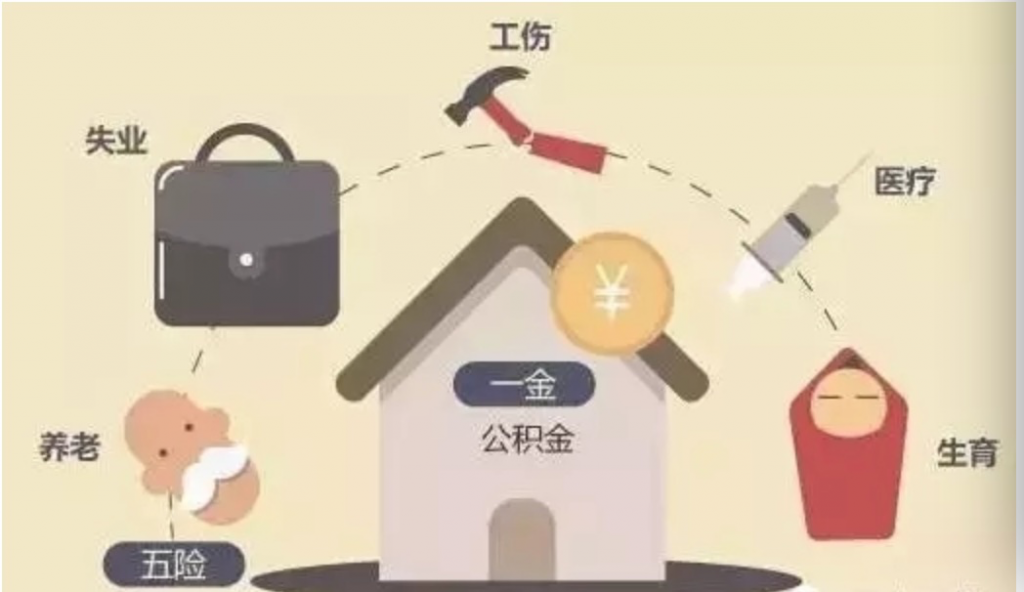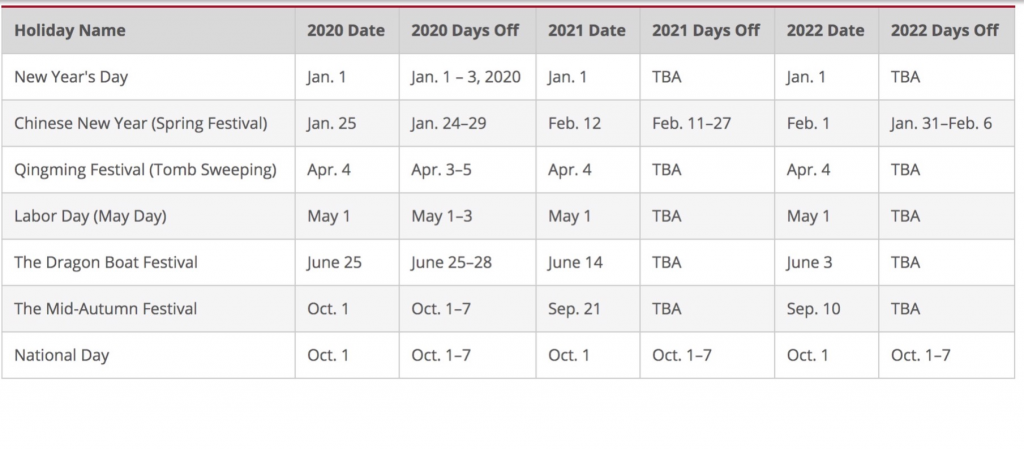
Content
Introduction and overview of the country
Recruitment practices
Selection practices
Miscellaneous information
Bibliography
Introduction and overview of the country
China represents 21.95% GDP of the world, is the second-largest economy in the world (Tradingeconomics.com, 2019). According to CEIC (2018), China had a population of 1.395 billion in Dec 2018. The unemployment rate was 3.8% in June 2018. And monthly earnings were 936.5 USD in Dec 2017.

There are two stages of the labour market. The first stage is the planned economy, which is characterized by the “Iron rice bowl” from 1949 to 1978, and the second stage is the socialist market economy from 1978 to present (Bamber, 2015). Prior to 1978, labour mobility was highly restricted to the hukou system with two residential statuses: urban and rural (Zhou, 2019). Since 1978, ease restrictions provide opportunities for migrations from rural to urban areas (Bamber, 2015). However, foreign workers need to apply for the Chinese Z work visa to legally work in China (TravelChinaGuide, n.d.).
Chinese government promotes full-time jobs, which are a five-day workweek with a maximum of 8 hours a day and a maximum of 44 hours a week (Travelchinaguide.com, 2019).
All-China Federation of Trade Unions is the only nationalized union ties to the Chinese Communist Party (CCP). And the Labour Law is the basic labour law of China that contains 107 articles in 13 chapters, including General Provisions, Promotion of Employment, Labour Contracts and Collective Contrast, and so on (China.org.cn, n.d.).
Recruitment practices
During the planned economy, enterprises were most state-owned so that HRM plays little role in a recruitment role. After the open-door economy, more foreign and private companies are formed that HRM plays an important role in recruitment and selection.
The initial recruitment is through the newspaper. Other recruitment channels in China include job fairs, employment centers, headhunters, advertisements in media, and so on (Kang & Shen, 2013). Since technology has developed rapidly, the most effective way of recruitment has changed to online professional recruiting platforms. Recruiting companies post job advertisements on social network sites, and job seekers can view online and submit their resume. The most reliable and popular recruitment sites in China are Chitu, 51job, Zhaopin, Liepin. Moreover, other sites including ChinaJob.com and LinkedIn are to attract international applicants.

(Sources: Asianclub.mit.edu, n.d.; Linkedin.com, n.d.; Mobileappdaily.com, 2019)
Because China has a large talent pool, there are 8 million recent graduates were looking for jobs in 2018 (SEAAGE – South East Asian Association of Graduate Employers, 2019). Therefore, campus recruitment is great way to recruit recent graduates. Students get to know about the companies through the internship program. And most of the graduates have no work experience so that the salary is not as high as the people who have work experience. It’s a good opportunity to recruit top students from the “985” and “211” projects.
13th-month pay indicates that employees can receive an extra month’s pay during Chinese New Year (January to February) if they have worked for the company for over 12 months (Corkran, 2019). Therefore, it is hard to recruit candidates from December to February, in which 13th-month pay and year-end bonus are given in that period.
Selection practices
Methods of selection
There are many ways to select talented workers: resume screening, reference letter verification, interview, psychometric test, and assessment center. And the selection criteria are based on expertise, job performance, communication skills, age and personality (Kang & Shen, 2013). The selection process is really diverse in China. However, the process could be resume screening qualified candidates, psychological tests, two rounds of interviews focus on professional knowledge and personality respectively (Kang & Shen, 2013).
What’s more, guanxi is the Chinese characterized informal selection approach, which is considered as social networks (Kenton, 2019). And the guanxi selection occurs both internal (referral from existing employees) and external (referral by people outside the organizations) (Liu, Potocnik, & Anderson, 2016).
Employers have the right to use the probation period in order to examine the ability and skills of the employees. The probation period varies from one to three months depends on the contract term, and salary should not be less than 80% of the minimum wages or the wages signed in the employment contract.
Miscellaneous information
Female Maternity Rights
According to the Special Provisions on Labor Protection of Female Workers, the maternity leave period is 98 days, which might differ from local authorities. 15 days of maternity leave period can be extended due to dystocia or additional baby. The employers are required to reduce the workload if the maternities can not adapt. During the pregnancy, childbirth, and breastfeeding, employers cannot reduce the wages, terminate contracts of the female employees. In addition, female employees can receive 15 days or 42 days of maternity leave respectively if a miscarriage occurs before a 4-month pregnancy or after a 4-month pregnancy.
The maternity subsidy will be paid by maternity insurance based on the standard of employees’ monthly salary (Liu & Yang, 2019).
There are five insurances and one fund is mandatory to be paid monthly by both employers and employees. The picture below from left to right showing the five insurances: pensions, unemployment insurance, occupational injury insurance, medical insurance, and maternity insurance. And one fund is the housing fund (Livermore, 2019).

Chinese Holidays and Leaves
There are seven public holidays each year, and some of the dates are changing every year due to the use of Chinese Lunar Calendar (China Highlights, 2019). And five to fifteen annual leave depends on the length of service (Boquen, 2019). People who work during the legal Chinese holidays should receive 3 times the contracted hourly salary (Boquen, 2019).

Bibliography
- About.linkedin.com. (2019). About LinkedIn. [online] Available at:
https://about.linkedin.com/ [Accessed 22 Oct. 2019]. - Asiaclub.mit.edu. (n.d.). [image] Available at: http://asianclub.mit.edu/zhaopincom
[Accessed 29 Oct. 2019]. - Bamber, G. J. and Lansbury, R. D. (2015) International and comparative employment relations : national regulation, global changes. Sage. Available at: https://search.ebscohost.com/login.aspx?direct=true&db=cat02755a&AN=cul.b1216265&site=eds-live&scope=site (Accessed: 22 October 2019).
- Boquen, A. (2019). How to Structure a Salary Package in China | NH Global Partners. [online] New Horizons Global Partners. Available at: https://nhglobalpartners.com/how-to-structure-a-salary-package-in-china/ [Accessed 21 Oct. 2019].
- Chinaeducenter.com. (2019). Project 211 and 985 – China Education Center. [online] Available at: https://www.chinaeducenter.com/en/cedu/ceduproject211.php [Accessed 23 Oct. 2019].
- China.org.cn. (n.d.). Labour Law of the People’s Republic of China — china.org.cn. [online] Available at: http://www.china.org.cn/living_in_china/abc/2009-07/15/content_18140508.htm [Accessed 27 Oct. 2019].
- China Highlights. (2019). China Holidays, Public Holidays Calendar in 2020/2021/2022. [online] Available at: https://www.chinahighlights.com/festivals/china-public-holiday.htm [Accessed 21 Oct. 2019].
- Corkran, M. (2019). 13th Month Pay – Decoding the Myths. [online] China Centric Associates. Available at: http://www.chinacentric.com/13th-month-pay—decoding-the-myths.html [Accessed 21 Oct. 2019].
- Ghosh, I. (2018). China population comparison map. [image] Available at: https://www.visualcapitalist.com/china-provinces-country-population/ [Accessed 28 Oct. 2019].
- HROne. (n.d.) Employee Probation Periods in China. [online] Available at: https://www.hrone.com/employee-probation-periods-china/ [Accessed 21 Oct. 2019].
- Kang, H. and Shen, J. (2013) ‘International recruitment and selection practices of South
- Korean multinationals in China’, International Journal of Human Resource Management, 24(17), pp. 3325–3342. doi: 10.1080/09585192.2013.770777.
- Kenton, W. (2019). Why Guanxi Matters. [online] Investopedia. Available at: https://www.investopedia.com/terms/g/guanxi.asp [Accessed 23 Oct. 2019].
- Linkedin. (2019). ChinaJob. [online] Available at: https://www.linkedin.com/company/chinajob.com [Accessed 22 Oct. 2019].
- Linkedin.com. (n.d.). [image] Available at: https://www.linkedin.com/company/51job
[Accessed 29 Oct. 2019]. - Liu, Z. and Yang, S. (2019). Employment & Labour Law 2019 | China | ICLG. [online] International Comparative Legal Guides International Business Reports. Available at: https://iclg.com/practice-areas/employment-and-labour-laws-and-regulations/china [Accessed 20 Oct. 2019].
- Livermore, A. (2019). Understanding China’s Social Security System – China Briefing News. [online] China Briefing News. Available at: https://www.china-briefing.com/news/chinas-social-security-system/ [Accessed 21 Oct. 2019].
- Mobileappdaily. (2019). [image] Available at: https://www.mobileappdaily.com/linkedin-
closing-down-chittu-a-chinese-language-app [Accessed 29 Oct. 2019].Niewenhuis, L. (2019). World Opinion On China Becomes More Negative. [image] Available at: https://supchina.com/2019/10/03/world-opinion-on-china-becomes-more-negative/ [Accessed 28 Oct. 2019]. - SEAAGE – South East Asian Association of Graduate Employers. (2019). Demystifying Campus Recruitment in China — SEAAGE – South East Asian Association of Graduate Employers. [online] Available at: https://www.seaage.org/2019/05/30/demystifying-campus-recruitment-in-china/ [Accessed 23 Oct. 2019].
- Shenlanbao (2017). [image] Available at: https://xueqiu.com/6277255800/86100451
[Accessed 29 Oct. 2019]. - Tradingeconomics.com. (2019). China GDP. [online] Available at: https://tradingeconomics.com/china/gdp [Accessed 20 Oct. 2019].
- Travelchinaguide.com. (2019). Business Hours in China, Working Times for Post Offices, Companies, Hospitals, Banks. [online] Available at: https://www.travelchinaguide.com/essential/business-hour.htm [Accessed 23 Oct. 2019].


